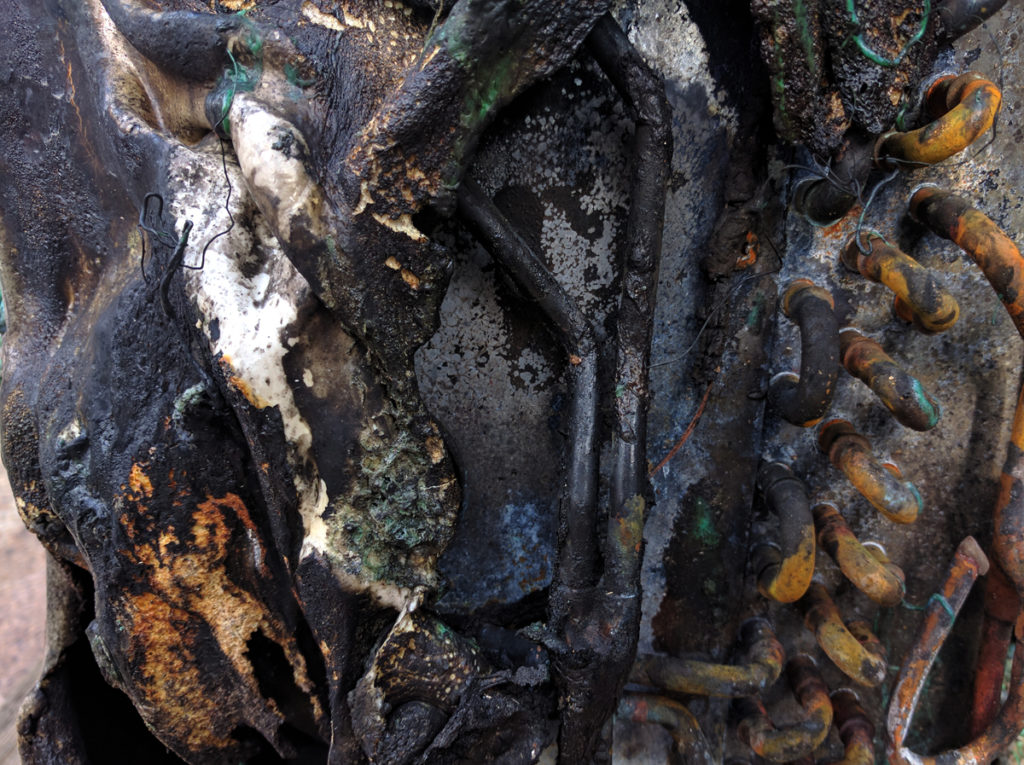URGENT REPORT
Protomunculus spp
Most technocenters and settled asteroids of the inner verse have at one time or another been found to harbor this enigmatic parasite. First documented on the trash moons of the Antillean arc, it appears to propagate through the dispersal of microscopic spores, light enough to waft on interstellar currents and armored against the vacuums of deep space and the heat of the inner atmosphere.
The metal-molds are an overlooked group of pioneering bioforms, commonly found embedded on the non-motive components of robionic organisms. Similar to the lichens of Old Earth, they often form symbiotic bonds with air-borne algae or other bioforms, exchanging the one’s ability to photosynthesize with the other’s capacity for synthesizing caustic acids. Protomunculus appears to represent a divergence from the typically benign metal-mold clan due to its startling adaptability and potential for destructive growth.
Initial stages of infection by Protomunculus closely resemble those of other metal-molds: surficial growths characterized by circular discolouration, yellowish-green if the symbiont is of the Old Earth orders or reddish-violet if it originates from beyond the Promethean Divide. During this stage it can only be differentiated from the traditional metal-molds by its preference for colonizing the motive joints and hinges of robionic shells, especially those proximal to the great electrovenic channels of the system.
After a period of time, the length of which is dependent on resource availability and light, Protomunculus sheds its habit for horizontal growth and delves deeply into the robionic host, seeking out the functional heart of the organism. As it begins to tap the host’s electrovenic channels, associations with the external bioform are cut, and all visible signs of parasitism disappear. Detection at this phase is dependent on meticulous analysis of the suspected host’s energetic budget to seek out the most minute of functional anomalies. Infected organisms will display increasing divergence from programmatic tasks and a phenomenon known as ‘feedback static.’ Even at this stage, all but the most wary of systemic administration units will likely attribute the anomalies to overdue maintenance or expected obsolescence.
Long before these external signs become visible, Protomunculus will have crept along the electrovenic channels to whatever constitutes the host’s nexus of power, as the grain of pollen grows slowly downward toward the waiting ovary. Once embedded, the mold begins to subvert the operative principles of the organism, utilizing its own power source to erode and reform its physical components. Using whatever plastico-silicate or metallic materials might be available, Protomunculus begins to fashion and armor the spores that will bring about its next generation.
After a significant portion of the host has been subverted and transformed, the mold fully overrides the organism’s programming and issues its final commands. To facilitate the widest possible dispersal of its spores, the parasite directs its host into a position that will bring it into contact with a strong fluid current. Depending on the physical capabilities of the host’s robionic body, this final command may take the form of an injunction to launch itself into or past atmospheric rotation, to scale and cling to a starscraper, or even to plunge itself into a pelagic stream. Once proximity to the desired current is achieved, total dissolution of the host’s body occurs as Protomunculus sporulates, sending millions or perhaps billions of fragments of itself to replicate this process in new and fertile ground.
The nature of the protomunculean parasite is such that an infection can quickly spread throughout and overcome even the most well-defended of technocenters. Its arrival has necessitated the abandonment of entire stellar bodies, and catastrophes have followed its trail through the stars. If an infected robionic is discovered at any stage, universal mandate requires its immediate incineration. Regional guidelines often recommend the incineration or quarantine of any other robionics it may have been in contact with. The spores have proven difficult to isolate and destroy, but they are large enough to be apprehended by the standard regulation air filtration systems of domed cities.
Given its viral nature, most of the prospective cures developed for Protomunculus infections have resulted in even more virulent strains of the mold, so attempts to combat it have resorted largely to preventative measures. We recommend regular physical examinations for all robionics and the application of certain oil-gels that inhibit the initial growth of metal-molds. Luckily for the robionic community of inhabited stellar bodies, the incidence of Protomunculus is rare and erratic, as it tends to rapidly burn through potential hosts and then mysteriously subside. To aid in visual detection of Protomunculus, study the attached illustrations carefully. For questions, observations or more specific information about analysis and detection, contact your regional consul of RIDO, the Robionic Infectious Disease Office.
NOT FOR GENERAL DISTRIBUTION
Alex Greene grew up hoping to become a 19th century naturalist. Finding that this vocation has gone extinct, he has turned to field biology, environmental education, organic farming and anthropology to make a living. Foraging wild plants, watching birds and hiking in the wilderness are his ways of participating in the great mystery of being.
